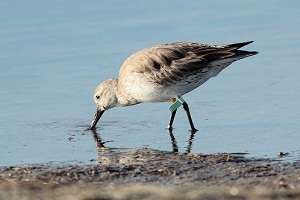Migratory birds find Kimberley safe haven via China

A sub-species of a small shorebird, spends much of the northern winter feeding at Roebuck Bay and Eighty Mile Beach in the Kimberley.
The red knot sub-species (Calidris canutus piersmai), breeds in the Siberian Arctic tundra, and travels to and from the Kimberley via China's Yellow Sea—a round trip of at least 20,000km.
PhD student Ying Chi Chan is one of a group of Netherlands-based scientists conducting detailed longitudinal studies of shorebirds' flight paths and foraging ecology.
"Habitat destruction is happening in a lot of places but the rate is particularly fast in China," she says.
"The main thing I want to know is how the bird adapts to this change in environments."
As a Masters student at the Royal Netherlands Institute of Sea Research, Ms Chan spent two months at Roebuck Bay last year with colleagues.
"The first thing we did is to put satellite tags on 15 red knots in that year … we already did that in the previous year," she says.
"We glued the tags on.
"We hoped to follow them to migration but the tags fell off before migration."
Her colleagues such as the Global Flyway Network's Chris Hassell, who is based in Broome for much of the year, have been colour-banding the birds' legs since 2006.
"From both the satellite tags and the colour ring sighting we know that the birds actually move around between Eighty Mile Beach and Roebuck Bay," she says.
"They use the whole bay and every different part is important for the birds, also in different tide levels."
The majority of the birds fly from Roebuck Bay to Bohai Bay, at the edge of the city of Tangshan, China.
"Its mudflats contain high densities of a species of shellfish (Potamocorbula laevis) which the knots can feed on and fuel up quickly for their next flight to Siberia," she says.
Meanwhile Ms Chan has trialled a more reliable harness device for attaching satellite tags to another sub-species of red knot, in the Netherlands' Wadden Sea.
"Hopefully next year I can tag the birds in Roebuck Bay in Australia, then we can track the whole migration," she says.
"For the fieldwork I'll mainly focus on China, because in China the site is being destroyed very quickly.
"It's only twenty-something kilometres of coast; like a bottleneck for the species and a really fragile place."
Parts of Bohai Bay's mudflats are being reclaimed for roads, factories and apartment blocks.
Provided by Science Network WA

















